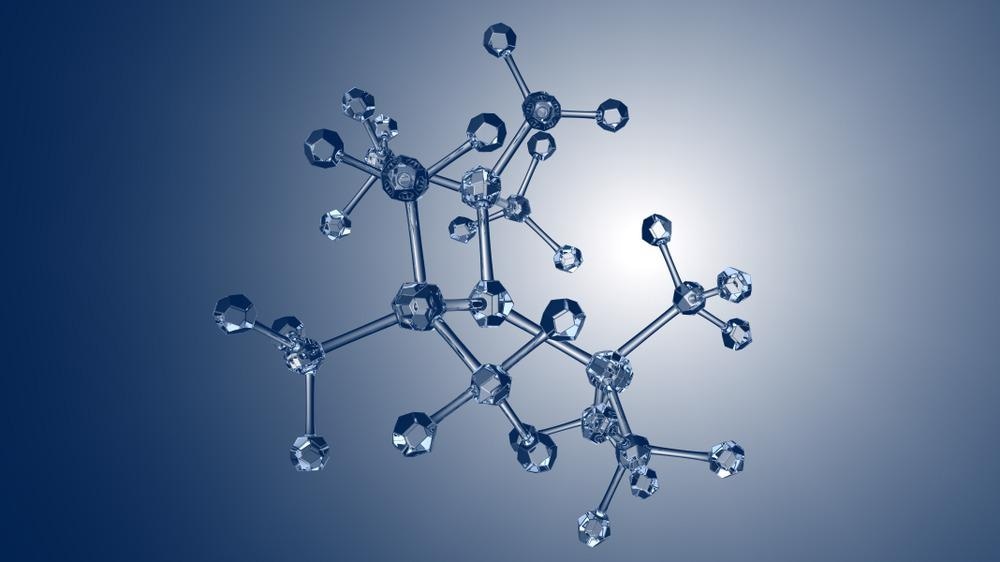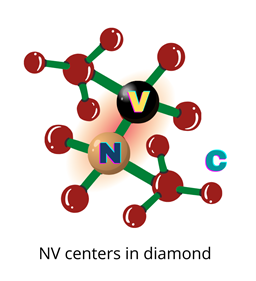Optically active structural defects in diamond offer a promising qubit platform for quantum computing.

Image Credit: Jimmy Ryan/Shutterstock.com
Diamond is an electrical insulator that exhibits high thermal conductivity.
There are many different types of impurities that can be found within the lattice structure of diamond. Nitrogen vacancy centers (NV centers) in particular are an interesting defect in diamond for technological applications due to their optical accessibility.
NV Centers in Diamond
An NV center is created when a nitrogen atom replaces one carbon atom, and a neighboring carbon atom is removed to form a vacancy within the diamond lattice (Figure 1). At this vacancy, an unpaired electron is trapped. The trapped electron circulates around the NV center. The spin of this electron can be manipulated to represent a qubit.

Figure 1: Illustration of how an NV center in a diamond lattice structure might look.
Advantages of NV Centers
NV centers have several unique features that make them promising for quantum information systems. The electron spin has a very long coherence time. The spin coherence can last up to several seconds which makes it ideal to control as a good qubit.
The qubit in an NV center also works in a large range of temperatures, up to room temperature. This is another favorable feature of NV centers as a quantum computing platform.
The electron spin in an NV center also couples to nuclear spins. This additional property provides another feature that can be used as extra qubits that can be used to store and process quantum information.
Furthermore, the electron spin of the NV center also interacts with photons. Photons are elementary particles of light. The ability to encode information from the electron spin to photons makes it possible to send quantum states over long distances. Such a hybrid system of NV centers and photons entangled over long distances is ideal to develop quantum networks.
Quantum Networks
A quantum network consists of several nodes that can store, process, and transmit data. A node can be established using NV centers consisting of multiple spins or qubits. The nodes can be linked together using optics into a network. Using this approach, a large quantum computer can be built by connecting many copies of small and simple quantum processors together.
Connecting simpler quantum processors together avoids the challenges of developing single chips with ever-increasing complexity. Optical connections can also go over long distances, making them favorable for quantum cryptography, enabling fundamentally secure communication.
Qubits with NV Centers
The electronic spin of the NV center is spin 1. To use it as a qubit, a two-level system of spin-up and spin-down has to be created. The spin-up can be regarded as 1 and the spin-down as 0. The spins are controlled by applying microwave pulses.
If the spin is pointing upwards at the start, a microwave pulse applied to the NV center, rotates the spin from up to down and then back up again in a coherent fashion. Exactly halfway in that rotation, a quantum superposition of spin-up and spin-down is produced. This creates a qubit that is both 0 and 1 at the same time that would form the basis of a quantum computer.
Lasers are used to measure the state of the spin. An electron in an atom can be excited or polarized by a laser. When excited, the electron emits a single photon as it falls back to a lower energy state. This fluorescence of the emitted photon is collected by using a photodetector.
There are different optical transitions in the NV center, each of which is associated with different spin states. When a laser pulse that is only resonant with a transition for spin-up is applied, then only the spin-up state of the NV center is excited. The photons that are detected through this process are associated with the spin-up state. If the spin is down, the laser will be off-resonant, and the state remains dark. This technique provides a way to read out the desired spin state.
Fabricating NV Centers in Diamond
There are different methods employed to create NV centers, for example, implantation of nitrogen into a pure crystal, electron irradiation by annealing at high temperatures, and chemical vapor deposition. Recently scientists have adapted high-quality synthetic diamonds to produce NV centers.
Outlook
While NV centers in diamond propose a promising platform for quantum information processing, some challenges remain. The collection efficiency of the read-out photons has to be increased to effectively account for the emitted light. Furthermore, fabricating NV centers with high spatial control and precision will improve the overall performance.
More from AZoQuantum: Applications of Quantum Sensing
References and Further Reading
Sébastien Pezzagna and Jan Meijer , "Quantum computer based on color centers in diamond", Applied Physics Reviews 8, 011308 (2021) https://aip.scitation.org/doi/10.1063/5.0007444
Sergei D. Trofimov, et al, "Spatially controlled fabrication of single NV centers in IIa HPHT diamond," Opt. Mater. Express 10, 198-207 (2020) https://opg.optica.org/ome/viewmedia.cfm?uri=ome-10-1-198&html=true
Liu Gang-Qin, Pan Xin-Yu. Quantum information processing with nitrogen–vacancy centers in diamond. Chinese Physics B, 2018, 27(2): 020304 https://iopscience.iop.org/article/10.1088/1674-1056/27/2/020304
Disclaimer: The views expressed here are those of the author expressed in their private capacity and do not necessarily represent the views of AZoM.com Limited T/A AZoNetwork the owner and operator of this website. This disclaimer forms part of the Terms and conditions of use of this website.